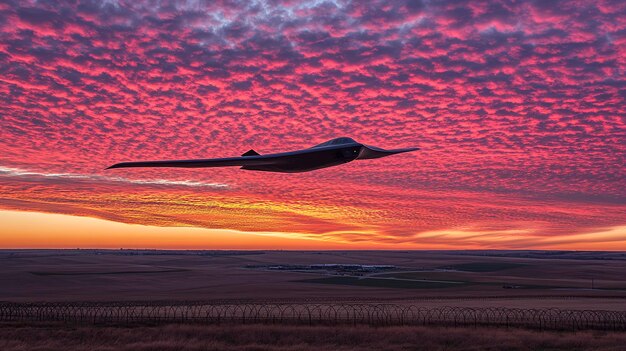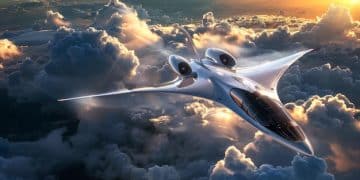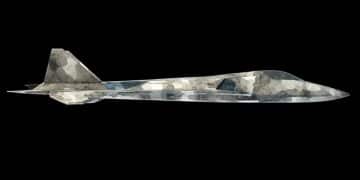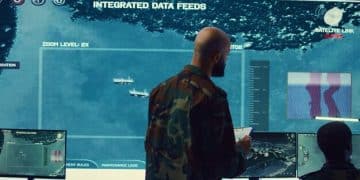US Military Modernization: Next-Generation Air Dominance Program Deep Dive

US military modernization is aggressively pursuing the Next-Generation Air Dominance (NGAD) program, a multi-faceted initiative designed to ensure air superiority for decades to come through advanced aircraft, networked systems, and cutting-edge technology.
The landscape of modern warfare is shifting, and maintaining air superiority demands constant evolution. The US Military Modernization: A Deep Dive into the Next-Generation Air Dominance Program represents a pivotal leap towards securing America’s aerial dominance in an increasingly complex global environment. This ambitious initiative is not merely about a new fighter jet; it’s a holistic approach to air warfare, integrating advanced platforms, revolutionary technologies, and seamless connectivity to reshape the future of combat aviation.
The Strategic Imperative for NGAD
The Next-Generation Air Dominance (NGAD) program is fundamentally a response to the evolving geopolitical landscape and the rapid advancements by peer competitors. The U.S. Air Force and Navy recognize that traditional platforms, while still potent, may eventually struggle to maintain an edge against sophisticated anti-access/area denial (A2/AD) systems and advanced fighter designs from adversaries. NGAD seeks to ensure that the U.S. retains its decisive qualitative advantage in the air, a cornerstone of its military strategy.
This program is less about a single “silver bullet” aircraft and more about a system-of-systems approach. It acknowledges that future aerial combat will be won not just by the fastest or stealthiest jet, but by an interconnected web of capabilities working in concert. This includes manned and unmanned platforms, advanced sensors, resilient communications, and innovative weapons systems, all orchestrated through a collaborative combat artificial intelligence (AI) ecosystem. The strategic imperative is clear: deny adversaries air superiority and project power effectively across contested domains.
Evolving Threats and Capability Gaps
The impetus for NGAD is largely driven by the emergence of new threats. Adversaries are developing increasingly capable fighter aircraft, long-range surface-to-air missiles, and sophisticated electronic warfare systems. These advancements seek to challenge U.S. aircrews and deny access to critical operational areas. The current generation of U.S. fighter aircraft, while highly advanced, was not designed to counter this specific confluence of capabilities, thus creating potential capability gaps that NGAD aims to bridge.
-
Advanced Fighter Aircraft: Proliferation of 5th-generation and nascent 6th-generation fighter development by China and Russia.
-
Integrated Air Defense Systems (IADS): Sophisticated, multi-layered ground and sea-based air defense networks that complicate traditional air operations.
-
Electronic Warfare (EW) Capabilities: Advanced jamming and spoofing technologies designed to degrade U.S. sensor and communication systems.
Addressing these gaps requires not just incremental improvements but a revolutionary step forward in air combat capabilities. NGAD is designed to proactively counter these emerging threats, ensuring that U.S. forces can operate effectively in highly contested environments. This forward-looking approach aims to maintain strategic deterrence and offer decision-makers a flexible and potent array of options.
The program underscores a shift from simply replacing aging assets to fundamentally redefining how air power is conceived and employed. It’s about future-proofing air superiority by anticipating and mitigating threats before they fully materialize. The investment in NGAD reflects a long-term commitment to maintaining a decisive advantage in a volatile global security landscape, ensuring that the U.S. military remains at the forefront of technological and operational innovation.
Key Pillars: Manned, Unmanned, and Networked Systems
The Next-Generation Air Dominance program transcends the traditional concept of a single manned fighter. Instead, it is built upon a synergistic integration of manned platforms, advanced unmanned systems, and a robust, resilient network. This multi-layered approach aims to maximize combat effectiveness, distribute risk, and leverage the strengths of both human ingenuity and machine efficiency. The synergy between these pillars is what truly distinguishes NGAD from previous generations of air combat development.
The future battlespace will likely be too complex and lethal for any single platform to dominate. By combining crewed aircraft with a fleet of uncrewed autonomous platforms, the U.S. military aims to create a force multiplier effect. The manned component provides the cognitive advantage of human decision-making and adaptability, while the unmanned systems offer scalability, persistence, and the ability to operate in higher-risk environments. This division of labor allows for more flexible and effective mission execution across a wide spectrum of combat scenarios.
Collaborative Combat Aircraft (CCAs)
A central component of the NGAD ecosystem is the development of Collaborative Combat Aircraft (CCAs). These are advanced uncrewed platforms designed to operate alongside and in concert with manned fighters, like the NGAD fighter or F-35s. CCAs are envisioned as highly autonomous, AI-enabled drones that can perform a variety of missions, including reconnaissance, electronic warfare, missile carriage, and even acting as decoys to drawing enemy fire. Their integration allows manned aircraft to remain at a safer distance while extending the sensor and weapons reach of the overall air combat formation.
-
Force Multipliers: CCAs can significantly increase the combat power of a single manned aircraft, allowing it to control multiple unmanned wingmen.
-
Distributed Lethality: Spreading sensors and weapons across multiple platforms makes the overall force more resilient to attack and harder for an adversary to target effectively.
-
Risk Mitigation: Unmanned systems can undertake missions that are too dangerous for human pilots, preserving valuable human capital.
The CCA concept represents a paradigm shift in air combat; it moves beyond simple remote-controlled drones to highly autonomous systems capable of complex decision-making and collaborative action. This approach will allow for greater flexibility in mission planning and execution, adapting to rapidly changing tactical situations. The development of CCAs is a testament to the U.S. military’s commitment to leveraging advanced autonomy and artificial intelligence to redefine air warfare.

The network itself is perhaps the most crucial element, acting as the nervous system for this distributed force. It must be resilient, secure, and capable of transmitting vast amounts of data at high speeds. This network enables real-time synchronization between manned and unmanned assets, allowing for dynamic tasking, shared situational awareness, and rapid decision-making. Developing this robust, adaptive network is a challenge but essential for maximizing the potential of the NGAD system-of-systems. This integrated approach ensures that the total sum of capabilities is greater than its individual parts, creating a truly formidable aerial advantage.
Advanced Technologies Driving NGAD Innovation
The Next-Generation Air Dominance program is a nexus of cutting-edge technological development, pushing the boundaries of what’s possible in aerospace and defense. This is not just about incremental improvements to existing systems; it’s about revolutionary advancements in propulsion, stealth, sensing, and digital engineering that collectively form the bedrock of NGAD’s capabilities. These technologies are crucial for operating and succeeding in the highly contested environments envisioned for future conflicts, where traditional approaches may prove insufficient.
The core philosophy behind these technological investments is to achieve overmatch against any potential adversary. This involves developing capabilities that are not merely equivalent but demonstrably superior, creating dilemmas for enemy forces and providing U.S. aircrews with a decisive advantage. From revolutionary materials to intelligent software, every component is rigorously designed to contribute to a synergistic whole, making the NGAD system more capable, adaptable, and survivable.
Revolutionary Propulsion Systems
One of the most critical technological advancements underpinning NGAD is the development of revolutionary propulsion systems. These are essential for meeting the program’s demanding performance requirements, including extended range, high speed, and increased power generation for advanced sensors and electronic warfare systems. Adaptive Cycle Engines (ACE), for instance, represent a significant leap forward, offering the ability to switch between high-efficiency and high-thrust modes depending on mission needs. This flexibility provides an unprecedented operational range and speed advantage.
-
Adaptive Cycle Engines (ACE): Optimize fuel efficiency for long-range cruise and maximize thrust for high-speed intercepts, offering unprecedented versatility.
-
Thermal Management: Advanced systems to dissipate heat generated by powerful sensors and electronic warfare, crucial for stealth and system longevity.
-
Embedded Power Generation: Integrates power generation directly into the engine, providing ample electricity for future high-power onboard systems.
These propulsion innovations are not just about making an aircraft faster or fly further; they are about enabling a whole new class of capabilities. Enhanced power generation, for example, is vital for operating the sophisticated active electronically scanned array (AESA) radars and powerful electronic warfare suites that will define NGAD’s sensor and self-protection capabilities. The focus on efficiency, range, and raw power output ensures that NGAD platforms will have the endurance and energy reserves necessary for sustained operations in diverse and challenging theatres.
Beyond propulsion, NGAD also integrates advancements in materials science, particularly for enhanced stealth characteristics and structural integrity, and highly advanced sensor fusion systems that can process vast amounts of data from multiple sources to create a complete and accurate picture of the battlespace. These technologies are not just theoretical; they are being rigorously developed and tested to ensure they meet the stringent demands of future military operations. This comprehensive technological push ensures NGAD will be at the forefront of air combat for decades to come.
Digital Engineering and Rapid Prototyping
A fundamental shift in the development of the Next-Generation Air Dominance program is its heavy reliance on digital engineering and rapid prototyping. Unlike previous aircraft programs that often followed a sequential, hardware-centric development model, NGAD is harnessing the power of digital tools, simulations, and iterative design to accelerate development cycles, reduce costs, and enhance flexibility. This approach allows for quicker testing of concepts, faster integration of new technologies, and a more adaptive response to evolving requirements.
Digital engineering involves creating a comprehensive virtual model of the aircraft and its systems, allowing engineers to simulate performance, conduct virtual tests, and identify potential issues long before physical components are manufactured. This front-loaded problem-solving significantly reduces the risk and cost associated with traditional physical prototyping. It’s about building it right the first time, virtually, before committing to expensive physical construction. This paradigm shift in methodology is set to revolutionize military acquisition and development processes.
Model-Based Systems Engineering (MBSE)
At the heart of NGAD’s digital transformation is Model-Based Systems Engineering (MBSE). MBSE uses computer models as the primary method for defining, designing, and documenting complex systems. Instead of relying on traditional text-based documents and drawings, MBSE creates a central, authoritative digital source of truth for all aspects of the system. This allows for better collaboration across diverse engineering teams and ensures consistency and traceability throughout the development lifecycle.
-
Enhanced Collaboration: Different engineering disciplines can work on the same digital model simultaneously, improving integration and reducing errors.
-
Early Problem Detection: Identifying design flaws or integration issues in the virtual environment saves time and resources downstream.
-
Improved Verification: Detailed simulation and analysis capabilities allow for rigorous virtual testing of system performance against requirements.
MBSE not only streamlines the design process but also provides a dynamic platform for continuous iteration and optimization. Changes made to one part of the model can instantly propagate throughout the entire system, allowing engineers to understand the cascading effects of design decisions. This holistic view is crucial for developing a highly integrated and optimized system-of-systems like NGAD, ensuring that all components work together seamlessly to achieve operational objectives.
The emphasis on rapid prototyping complements digital engineering by allowing for quick transition from virtual designs to tangible test articles. These physical prototypes, often 3D-printed or quickly manufactured using agile processes, are used to validate certain aspects of the design or to test integration concepts in a real-world environment. This iterative build-test-learn cycle, powered by digital models, ensures that the NGAD program remains agile, responsive, and innovative, adapting to new threats and technological opportunities with unprecedented speed.
Challenges and Criticisms on the Path to Dominance
While the Next-Generation Air Dominance program promises a revolutionary leap in air combat capabilities, it is not without its substantial challenges and criticisms. The sheer scale, technological ambition, and potential cost of NGAD present significant hurdles that must be navigated. These challenges range from technical complexities and budgetary constraints to policy debates and the need for a cultural shift within the military. Addressing these issues is paramount for the program’s successful realization and integration into the broader defense strategy.
The secretive nature of parts of the program, while necessary for national security, also makes public oversight and detailed analysis difficult, leading to speculation and concerns about transparency. Furthermore, the rapid pace of technological change means that even cutting-edge designs risk obsolescence if not managed carefully throughout their lifecycle. The path to achieving next-generation air dominance is fraught with complexities that extend far beyond engineering alone.
Cost and Affordability Concerns
Perhaps the most prominent challenge facing the NGAD program is its projected cost. Estimates suggest that individual NGAD platforms could cost hundreds of millions of dollars, making them significantly more expensive than current-generation fighters. This raises serious questions about affordability and the ability to procure these systems in sufficient numbers to meet operational needs. Critics argue that diverting so many resources to a single, high-cost program could jeopardize other critical defense priorities. The balance between technological superiority and practical affordability is a constant tension.
-
Per-Unit Cost: The anticipated astronomical cost per NGAD platform could limit production numbers, impacting overall force structure.
-
Program Sustainment: Long-term maintenance, upgrades, and operational costs for such advanced systems are likely to be substantial throughout their lifespan.
-
Budgetary Competition: NGAD competes for funding with other vital defense programs, potentially leading to difficult trade-off decisions.
The high cost necessitates a robust justification for the return on investment and a clear strategy for managing lifecycle costs. The Air Force and Navy are exploring various acquisition strategies, including modular design and open architectures, to potentially reduce future upgrade costs and ensure long-term affordability. However, the initial investment remains a significant point of contention and requires careful strategic planning to avoid becoming a “boutique” fleet rather than a broadly deployed capability.

Beyond cost, other challenges include the sheer technical complexity of integrating disparate systems into a cohesive “system of systems,” ensuring cybersecurity for highly networked platforms, and developing the necessary human capital (pilots, maintainers, software engineers) to operate and sustain these advanced capabilities. The program also faces the perennial challenge of managing the balance between speed of development and rigorous testing to ensure safety and reliability. These multifaceted challenges underscore the demanding nature of this ambitious modernization effort.
Integrating NGAD into Future Warfighting Concepts
The Next-Generation Air Dominance program is not an isolated endeavor; its very purpose is to integrate seamlessly into and fundamentally reshape future warfighting concepts. NGAD embodies the shift towards highly networked, data-driven, and distributed operations, moving away from centralized, platform-centric approaches. Its success hinges on its ability to enhance joint force capabilities, enabling new tactics, techniques, and procedures (TTPs) that leverage its unique blend of manned, unmanned, and networked assets, transforming how conflicts are planned and executed across all domains.
The program is set to become a cornerstone of the U.S. military’s strategy for achieving all-domain superiority. It will provide the necessary air superiority to enable operations by ground, naval, and space forces, while also facilitating long-range strike, intelligence gathering, and command and control functions. NGAD is designed to be highly interoperable, ensuring it can operate effectively with allied forces and integrate into a broader global force posture, enhancing collective security efforts.
Joint All-Domain Command and Control (JADC2)
A critical enabler for NGAD’s operational effectiveness is its deep integration with the Joint All-Domain Command and Control (JADC2) concept. JADC2 aims to connect sensors from all military services (Air Force, Army, Navy, Marine Corps, Space Force) into a single network, allowing for faster decision-making and more effective employment of forces across land, sea, air, space, and cyber domains. NGAD platforms, with their advanced sensors and networking capabilities, are envisioned as key nodes within the JADC2 construct, contributing to shared situational awareness and rapid targeting solutions.
-
Seamless Data Flow: NGAD systems will contribute vast amounts of real-time data to the JADC2 network, enhancing the common operating picture.
-
Dynamic Targeting: The ability to quickly identify and engage targets across domains, leveraging the speed and reach of NGAD assets.
-
Resilient Communications: NGAD’s robust network will provide redundant and secure communications pathways within the JADC2 framework.
This integration means that an NGAD fighter or its accompanying CCAs could identify a threat, share that information instantaneously across the JADC2 network, and then enable a response from a diverse array of assets—whether that’s another air superiority fighter, a naval ship, or ground-based long-range fires. This multi-domain synergy is designed to overwhelm adversary decision cycles and provide overwhelming combat power, ensuring the U.S. and its allies can dictate the pace and scope of future conflicts.
The successful integration of NGAD will also require significant changes in training, doctrine, and organizational structures. Pilots and ground crews will need to adapt to a more automated and networked battlespace, while military planners will need to develop new operational concepts to fully exploit NGAD’s capabilities. This comprehensive transformation ensures that NGAD is not merely an advanced piece of hardware but a cohesive component of a future-ready, integrated fighting force capable of meeting the challenges of the 21st-century security environment.
The Future Outlook for US Air Superiority
As the Next-Generation Air Dominance program continues its trajectory, its future outlook is deeply intertwined with the evolving global power dynamics and technological race. The aggressive pursuit of NGAD by the U.S. military signals a clear commitment to maintaining air superiority, not just as a tactical advantage, but as a strategic imperative for global stability and deterrence. The program’s success will redefine the parameters of air warfare for decades to come, influencing both peer competitors and allied nations. Its impact will extend beyond pure military capability, fostering innovation in related industries and shaping future defense budgets and international partnerships.
The ultimate goal is to create an air force that is not just capable of fighting today’s wars but is inherently adaptable to the unforeseen challenges of tomorrow. This forward-looking vision positions the U.S. at the forefront of military aviation, ensuring its ability to project power, protect interests, and deter aggression in a rapidly changing world. The future of U.S. air superiority hinges decisively on the successful and timely development and deployment of the NGAD system-of-systems.
Impact on Global Balance of Power
The development and deployment of NGAD will undoubtedly have a profound impact on the global balance of power. By maintaining a qualitative edge in air superiority, the U.S. aims to deter potential adversaries from aggressive actions and provide its allies with greater security assurances. The advanced capabilities of NGAD, particularly its ability to operate effectively in highly contested environments, may force adversaries to rethink their own military strategies and investments, potentially leading to a new arms race or shifting the focus of their defense strategies.
-
Deterrence Enhancement: A clear qualitative edge in air combat strengthens U.S. deterrence against aggression.
-
Allied Integration: NGAD’s networked architecture offers opportunities for closer integration and interoperability with key allies, enhancing collective defense.
-
Strategic Stability: Maintaining air superiority ensures freedom of action for U.S. and allied forces in critical regions, contributing to regional and global stability.
The program’s success is also likely to influence the strategic calculations of other major military powers, potentially accelerating their own modernization efforts in related fields such as autonomous systems, advanced networking, and stealth technology. This dynamic competition underlines the importance of NGAD not just for tactical advantage, but for its broader strategic implications in shaping the future of international relations and military strategies worldwide. The pursuit of NGAD is a clear signal that the U.S. intends to remain the preeminent air power for the foreseeable future.
As the program progresses, continuous adaptation and innovation will be key. The modular and open-architecture approach of NGAD is designed to allow for rapid technology insertion and upgrades, ensuring that the system remains at the cutting edge throughout its operational life. This adaptability is crucial in a world where technological advancements can quickly render even advanced systems obsolete. Ultimately, the future outlook for U.S. air superiority is one of sustained investment, continuous innovation, and strategic foresight, with NGAD at its core.
| Key Aspect | Brief Description |
|---|---|
| ✈️ NGAD Scope | A system-of-systems, not just one aircraft, integrating manned, unmanned, and networked capabilities for future air superiority. |
| 🤖 Collaborative Combat Aircraft (CCAs) | Autonomous drones operating with manned aircraft as loyal wingmen, extending range, sensors, and weapons. |
| 🚀 Advanced Technologies | Features like adaptive cycle engines, enhanced stealth, advanced sensors, and digital engineering for rapid development. |
| 💸 Challenges | Significant cost, technical complexity, and integration into existing military structures represent major hurdles. |
Frequently Asked Questions About NGAD
The NGAD program is a U.S. military initiative to develop a comprehensive system-of-systems for maintaining air superiority. It includes a manned fighter, uncrewed collaborative combat aircraft (CCAs), advanced sensors, networking capabilities, and innovative weapons. Its goal is to counter emerging threats and ensure the U.S. retains its dominant edge in aerial warfare.
Unlike previous programs focused on a single manned fighter, NGAD is a “family of systems.” Its core difference lies in the deep integration of manned platforms with multiple autonomous CCAs, leveraging AI and advanced networking. This distributed approach aims to enhance lethality and survivability, extending beyond the capabilities of a standalone fighter.
CCAs are autonomous, uncrewed aircraft designed to operate alongside manned fighters, acting as “loyal wingmen.” Their roles vary, including reconnaissance, electronic warfare, missile carriage, and decoys. By deploying CCAs, NGAD can extend its sensing and weapons range, multiply combat power, and undertake higher-risk missions without endangering human pilots.
NGAD relies on several advanced technologies, including adaptive cycle engines for flexible power and range, advanced stealth materials and designs, highly integrated sensor fusion for comprehensive situational awareness, and robust, resilient networked communications. Digital engineering and rapid prototyping are also crucial for accelerate development and iterations.
Significant challenges include the program’s potentially enormous cost, raising concerns about affordability and procurement numbers. Technical complexities in integrating diverse manned and unmanned systems, ensuring cybersecurity of networked components, and adapting military doctrine and training to this new paradigm also pose substantial hurdles that need to be overcome.
Conclusion
The Next-Generation Air Dominance program represents a critical inflection point in
U.S. military modernization, moving beyond incremental upgrades to a truly
revolutionary approach to air warfare. By intricately weaving together advanced
manned platforms, autonomous collaborative combat aircraft, and a resilient,
networked ecosystem, NGAD aims to ensure overwhelming air superiority against
any adversary for decades to come. While significant challenges, particularly
regarding cost and technical integration, remain, the strategic imperative is
clear: future air combat demands a distributed, data-driven, and highly adaptive
force. The outcomes of NGAD will not only redefine the capabilities of the U.S. Air
Force and Navy but will also profoundly impact the global balance of power and
shape the future of defense technology and allied partnerships. This ambitious
undertaking underscores a proactive commitment to maintaining a decisive edge
in an ever-evolving geopolitical landscape.





